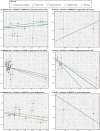Association of lipid-lowering drugs with risk of sarcopenia: a drug target mendelian randomization study and meta-analysis
- PMID: 38961447
- PMCID: PMC11223278
- DOI: 10.1186/s40246-024-00643-3
Association of lipid-lowering drugs with risk of sarcopenia: a drug target mendelian randomization study and meta-analysis
Abstract
Background: Lipid-lowering drugs are widely used among the elderly, with some studies suggesting links to muscle-related symptoms. However, the causality remains uncertain.
Methods: Using the Mendelian randomization (MR) approach, we assessed the causal effects of genetically proxied reduced low-density lipoprotein cholesterol (LDL-C) through inhibitions of hydroxy-methyl-glutaryl-CoA reductase (HMGCR), proprotein convertase subtilisin/kexin type 9 (PCSK9), and Niemann-Pick C1-like 1 (NPC1L1) on sarcopenia-related traits, including low hand grip strength, appendicular lean mass, and usual walking pace. A meta-analysis was conducted to combine the causal estimates from different consortiums.
Results: Using LDL-C pooled data predominantly from UK Biobank, genetically proxied inhibition of HMGCR was associated with higher appendicular lean mass (beta = 0.087, P = 7.56 × 10- 5) and slower walking pace (OR = 0.918, P = 6.06 × 10- 9). In contrast, inhibition of PCSK9 may reduce appendicular lean mass (beta = -0.050, P = 1.40 × 10- 3), while inhibition of NPC1L1 showed no causal impact on sarcopenia-related traits. These results were validated using LDL-C data from Global Lipids Genetics Consortium, indicating that HMGCR inhibition may increase appendicular lean mass (beta = 0.066, P = 2.17 × 10- 3) and decelerate walking pace (OR = 0.932, P = 1.43 × 10- 6), whereas PCSK9 inhibition could decrease appendicular lean mass (beta = -0.048, P = 1.69 × 10- 6). Meta-analysis further supported the robustness of these causal associations.
Conclusions: Genetically proxied HMGCR inhibition may increase muscle mass but compromise muscle function, PCSK9 inhibition could result in reduced muscle mass, while NPC1L1 inhibition is not associated with sarcopenia-related traits and this class of drugs may serve as viable alternatives to sarcopenia individuals or those at an elevated risk.
Keywords: HMGCR; Low-density lipoprotein cholesterol; Mendelian randomization; NPC1L1; PCSK9; Sarcopenia.
© 2024. The Author(s).
Conflict of interest statement
The authors declare no competing interests.
Figures




Similar articles
-
Associations of Lipid-Lowering Drugs With Blood Pressure and Fasting Glucose: A Mendelian Randomization Study.Hypertension. 2025 Apr;82(4):743-751. doi: 10.1161/HYPERTENSIONAHA.124.23829. Epub 2025 Feb 4. Hypertension. 2025. PMID: 39902581
-
Associations of genetically proxied inhibition of HMG-CoA reductase, NPC1L1, and PCSK9 with breast cancer and prostate cancer.Breast Cancer Res. 2022 Feb 12;24(1):12. doi: 10.1186/s13058-022-01508-0. Breast Cancer Res. 2022. PMID: 35151363 Free PMC article.
-
Novel insights into the association between genetically proxied inhibition of proprotein convertase subtilisin/kexin type 9 and risk of sarcopenia.J Cachexia Sarcopenia Muscle. 2024 Dec;15(6):2417-2425. doi: 10.1002/jcsm.13575. Epub 2024 Sep 10. J Cachexia Sarcopenia Muscle. 2024. PMID: 39254080 Free PMC article.
-
Lipids, lipid-lowering drugs and the risk of herpes zoster: a Mendelian randomization study.Arch Dermatol Res. 2025 Jan 4;317(1):166. doi: 10.1007/s00403-024-03600-1. Arch Dermatol Res. 2025. PMID: 39755897
-
Leveraging drug-target Mendelian randomization for tailored lipoprotein-lipid lowering.Curr Opin Lipidol. 2025 Apr 1;36(2):71-77. doi: 10.1097/MOL.0000000000000977. Epub 2025 Feb 20. Curr Opin Lipidol. 2025. PMID: 39973804 Review.
References
Publication types
MeSH terms
Substances
Grants and funding
LinkOut - more resources
Full Text Sources
Miscellaneous

